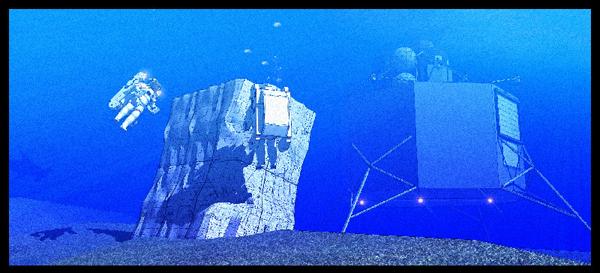NASA Builds Asteroid Landscape on Ocean Floor


Before humans explore an asteroid in space, a group of NASA astronauts and scientists will test concepts and techniques for the future expeditions on a mock space rock on the ocean floor.
This week, engineers are laying the foundations for the 15th expedition of NASA's Extreme Environment Mission Operations, or NEEMO 15 for short, which is scheduled to begin on Oct. 17. To prepare for that fall undersea mission, diving crews are setting up the tools and rocky environment needed to simulate an asteroid landscape. [Photos: Asteroids in Deep Space]
NEEMO expeditions take place at the National Oceanic and Atmospheric Administration's Aquarius Underwater Laboratory, which rests more than 62 feet (19 meters) below the ocean's surface, off the coast of Key Largo in the Florida Keys.
This year's NEEMO 15 expedition will simulate a trip to an asteroid, and the so-called "aquanauts" will investigate how best to anchor to the surface of a space rock and how to move around, said NASA spokesperson Brandi Dean.
To prepare for the 10-day October mission, various engineering tests will be conducted from May 9 to May 13 at the Aquarius laboratory. The NEEMO support team will perform surface dives to lay out the test site, including configuring a rock wall, NASA officials said. [Video: Rock & Roll Asteroids]
"The rock wall is going to be used to simulate the surface of an asteroid," Dean told SPACE.com. "For the engineering tests, it will be 16 by 12 feet. It's made of fiberglass panels. They'll try out different anchoring methods on it drilling into it or using metal plates to simulate magnetic anchoring."
The team will also check the communications system and perform preliminary tests for NEEMO 15. While the scientists and engineers will be hard at work on the ocean floor, they will not stay inside Aquarius.
Get the world’s most fascinating discoveries delivered straight to your inbox.
Unlike landing on the moon or Mars, an asteroid will have little, if any, gravity to exert on astronauts or their vehicles. NEEMO 15 will evaluate different anchoring methods, and different ways to connect multiple anchors to form pathways.
"Even experts don't know what the surface of an asteroid is going to be like," NEEMO Project Manager Bill Todd said in a statement. "There may be asteroids that we don't even know about yet that we'll be visiting. So we're figuring out the best way to do that." [5 Reasons to Care About Asteroids]
NEEMO 15's prime mission objectives will be to test operational concepts needed to explore near-Earth asteroids. As the aquanauts operate and test these concepts, they will provide information and valuable feedback to NASA engineers.
"Unlike Mars or the moon, asteroids have very little gravity," Dean said. "Performing spacewalks on asteroids will be similar to performing spacewalks at the space station. Performing the tasks underwater is one of the best ways to simulate what it would be like to perform them in space that's why astronauts practice for spacewalks underwater at the Neutral Buoyancy Laboratory."
Manned deepwater submersibles that function as Space Exploration Vehicles (SEVs) will also be used, and the aquanauts will perform Extra-Vehicular Activities (EVAs) to assess the efficiency of different operations.
NASA uses the Aquarius laboratory and the ocean floor to simulate aspects of a low-gravity environment and to help researchers understand factors relevant for real space missions.
You can follow SPACE.com Staff Writer Denise Chow on Twitter @denisechow. Follow SPACE.com for the latest in space science and exploration news on Twitter @Spacedotcom and on Facebook.
This story was provided by SPACE.com, a sister site to OurAmazingPlanet.

Denise Chow was the assistant managing editor at Live Science before moving to NBC News as a science reporter, where she focuses on general science and climate change. Before joining the Live Science team in 2013, she spent two years as a staff writer for Space.com, writing about rocket launches and covering NASA's final three space shuttle missions. A Canadian transplant, Denise has a bachelor's degree from the University of Toronto, and a master's degree in journalism from New York University.


